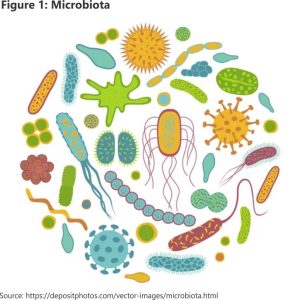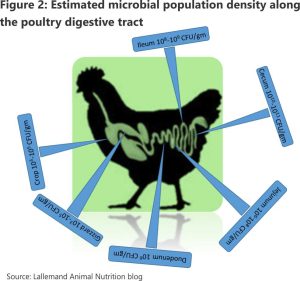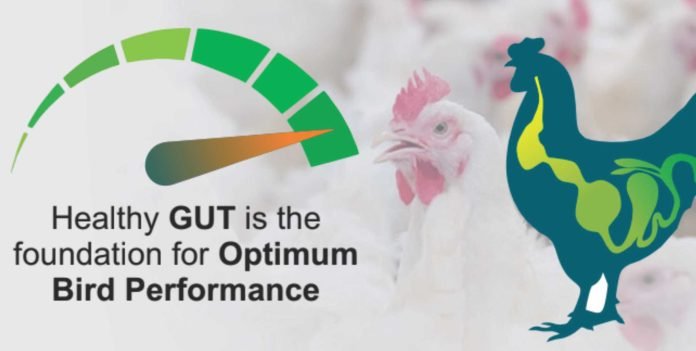

In poultry, the microbiota of the gastrointestinal tract (GIT) has demonstrated its importance for the host’s health, as it positively impacts the immune system, the physiology of the GIT, and the bird’s productivity. Through competitive exclusion and the generation of bacteriostatic and bactericidal chemicals, the microbiota of a chicken contributes to minimizing and preventing colonization by intestinal pathogens.
Inflammation, leaky gut, and other conditions connected to the gut can consequently be

What is microbiota? – its relationship with host species
The term “microbiota” refers to the entire community of microbes that live on or inside a complex multicellular organism (plants, animals, and humans), including commensal, symbiotic, and pathogenic microbes (Figure 1). The complex interactions between the microbiota and its hosts, which can be either beneficial (symbiotic) or harmful (pathogenic), can have a significant impact on both human and animal health. Over the past few years, understanding of the microbiota’s significance to both human and animal health has progressively increased. Currently, studies are going beyond the examination of correlations to uncover interconnected relationships between the microbiota, host and pathogenic bacteria. These investigations have unequivocally shown that the microbiota and the products they produce are crucial for not only gut development but also for innate immune system development in the host, thereby, performing multifactorial impacts on the host’s health.


The chicken gut is home to more than 100 trillion microorganisms, whose members include bacteria, fungi, protozoa, and viruses. Among these microbes, bacteria play a dominant role in intestinal functions. They are colonized in several parts with great diversity. Lactobacilli and Streptococci typically account for 103–105 colony-forming units/g (CFU/gm) in the crop and gizzard. The ileum has the richest bacterial community in comparison to the rest of the small intestine, while the duodenum has the lowest bacterial density (Figure 2).
Most of the microbiota community in the duodenum are Lactobacilli and Bifidobacteria. Lactobacilli, Enterococci, and Clostridiaceae are commonly detected in the jejunum, while

Functions of gut microbiota
1. Providing important metabolites
One of the key functions of the gut microbiota is extracting essential nutrients from the diet and making them available to the chicken. This entails the extraction, absorption, and synthesis of a wide range of biochemicals with growth-promoting properties, such as lactic acid, complementary enzymes, non-starch polysaccharides (NSPs), and water- or lipid-soluble vitamins (such as vitamin B and vitamin K), organic acids, and antimicrobial substances. The cecal microbiota actively digests soluble food fibers and resistant starch to create metabolites including short-chain fatty acids (acetate, butyrate, and propionate), which are advantageous to chickens’ physiological processes. The nitrogen and drug metabolisms are both influenced by the intestinal flora. Therefore, host metabolism, gut health, and gut microbial fermentation are all impacted by an imbalance in the microbial community.
2. Maintenance of gut homeostasis
Gut microbiota influences intestinal homeostasis and maintaining a balanced homeostasis supports the tolerance for infections and non-pathogenic stressors. As significant moderators of host-microbiota communication, metabolites, which are regulated by the microbiota, work closely with the host immune system, and thereby mediate several immune signalling pathways. Therefore, properly regulated metabolites affect chicken intestinal health and growth as well as immunological homeostasis.
3. Protecting gut barrier functions
The protection of gut barrier functions to enhance gut health is another role played by the gut microbiota. By adhering to the enterocyte’s epithelial walls and preventing the colonization of harmful bacteria, the gut microbiota defends the intestinal barrier. In addition, Lactobacillus plantarum, Lactobacillus reuteri, and Lactobacillus rhamnosus are among the helpful bacteria that aid in the growth of the mucosal epithelia, particularly immune cells whose main job is to defend the gut wall against infections. The inner layer of the mucus functions as a highly efficient first line of defense against pathogenic microbiota, such as Clostridium jejuni and Helicobacter pylori. Additionally, the commensal microbial population uses competitive exclusion to prevent pathogen invasion, maintaining gut homeostasis. Through the mechanism of competitive exclusion, the bacterial population of the intestinal microbiota forms a protective barrier that lines the gut, inhibiting the growth of less favourable or pathogenic bacteria like Salmonella, Campylobacter, and Clostridium perfringens. The attachment sites on gut cells are thought to be dominated by commensal (or friendly) bacteria, which prevents pathogens from adhering and colonizing there. According to a different view, the gut microbiota secretes chemicals called bacteriocins, which inhibit the growth of harmful bacteria and foster an environment unsuitable for their development.
Gut-Brain axis and gut health
The bidirectional communication mechanism between the GI tract and the central nervous system is known as the “gut-brain axis,” and it is crucial in modulating neuronal, immunological, and hormonal signals. Using visceral messages, this intricate system enables the gut to influence the brain. In order to send signals to the brain, these visceral messages produced by the host or gut bacteria interact with the enteric nervous system. In response, signals from the brain influence the gut functions (motor, sensory, and secretory modalities) and immune function. This dual relationship between the gut and the brain affects local pathological processes in addition to the gut’s physiology. Additionally, it causes leucocytes to discharge cytokines from the gut into circulation. Cytokines also cause the central nervous system to become active. The chicken gut microorganisms also stimulate the central nervous system by producing neurotransmitters. The hypothalamic-pituitary-adrenal (HPA) axis is stimulated by all these gastrointestinal events, raising serum corticosterone levels. In order to adjust inflammation, corticosterone regulates heterophile migration into the GI inflammatory site. Additionally, because the HPA axis is activated, chickens exhibit sick behaviour as a result of increased cortisol output.
No doubt, our understanding of the microbiome has completely changed because of this fusion of microbiology and neurology. The microorganisms that live in various niches in host organisms, including the digestive system, serve and have a significant impact on many critical physiological processes. Thus, the discovery that the gut microbiome functions as a sort of “microbial organ” has significant ramifications for numerous biological disciplines. Growing poultry research is being done on the impact of the microbiome on host physiology, particularly in light of the development of new-generation molecular tools that are revolutionizing the discipline of microbiology.


A deeper understanding of gut and gut health is vital for the profitable chicken industry. Gut health is a very broad subject, which involves gut anatomy and physiology, microbiota, immune function, and nutrition. All these different approaches work in an interdependent manner for optimum gut functioning while protecting the gut health of chickens. The intestinal microbiome acts as a signalling hub that connects environmental factors like nutrition with genetic and immunological signals, and it affects the host’s metabolism, immunity, and reaction to infection. Therefore, understanding the interplay between the microbiota and the host is crucial because it establishes the foundation for a healthy gut.
Arpana Verma Mukherjee & Sudipto Haldar, Agrivet Research & Advisory













